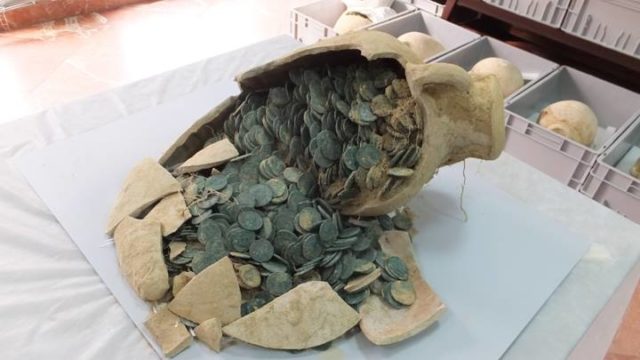In Tomares, Spain, whilst digging ditches and laying pipes, workers stumbled upon a literal treasure trove.
It seems that sometime in the past, one person (or several people) buried nineteen jars filled with Roman coins in what would become Zaudin Park. Naturally after the find, all work on the park has been halted for now.
Experts are hailing the discovery as unique. Nine of the nineteen jars (or amphoras) were intact — although several broke during excavation — and all of the jars contained thousands of bronze and silver-coated coins.
Buried about a meter deep, the jars weighed a total 1,300 pounds. After their recovery, they were brought to the Seville Archaeological Museum.

The coins within the jars, according to the Seville Archaeological Museum, date from the end of the fourth century. At the time of their burial, they are believed to have been newly minted.
They bear the images of emperors Constantine or Maxmian on one side, and on the other side, the images appear to be from various Roman stories.
The museum had nothing similar to these coins in their collection, and once the coins have been thoroughly examined they will be put on display for the public.
Ana Navarro Ortega, head of the museum, said that they had contacted counterparts in Britain, France, and Italy. Apparently, the Tomares jars are one of the most important finds from the period.
Primeras imágenes del hallazgo de monedas romanas de Tomares en el #MuseoArqueologico de Sevilla pic.twitter.com/5aK5fovNjj
— Consejería Cultura (@CulturaAND) 28 April 2016
Excavation of the jars is difficult due to their weight and fragility. As previously mentioned, several of the jars broke during the process, despite the care taken by archaeologists.
“I can assure you that the jugs cannot be lifted by one person because of their weight and the quantity of the coins inside,” Ortega said. “So now what we have to do is begin to understand the historical and archaeological context of this discovery.”
For now, researchers are puzzling over the reason that the jugs were buried in the first place. Currently, there are several theories floating around academic circles.
It is evident that the jars were deliberately concealed. Bricks and ceramic filler were layed over the treasure. One theory, from the Andalusian Department of Culture, for the coins’ existence in such large numbers is that the money was set aside to pay imperial taxes or army levies.
It’s important to note that Rome had begun to conquer Spain in 218 BC.Their rule their continued until the fifth century.
Richard Wiegel, who is a professor of ancient Greece and Rome at Western Kentucky University in regard to the discovery. Professor Wiegel suggested that the coins could have been buried during an era of “great discord in the Roman Empire.”
Ahora en @cuatro la directora del #MuseoArqueologico de Sevilla habla del hallazgo de monedas romanas pic.twitter.com/Vu4B4yjiJO
— Consejería Cultura (@CulturaAND) 28 April 2016
This could be likely because it was during the third century that the central authority in Rome broke down, said Professor Wiegel. Germanic tribes were a consistent problem, as they invaded the country periodically. On top of that, there were the usual challenges of ruling an empire.
The coins were discovered in Tomares, in southern Spain, and during the time of Roman rule, the area would have been considered a distant land.
It would have taken a while before it was considered a normal part of the Roman Empire, said Wiegel.
“The suggestion that they were collected to pay taxes to the Roman Empire is, of course, possible,” he said.
“But I suspect that they could have been stored to pay one of the Roman legions in the area and to hide the money from invaders in the region.”
When researchers identified the emperors on the coins, it did help to solidify their theories about the coins. If they knew what the political and social climate was during the time of the burial, then it becomes an easier task of formulating hypotheses.